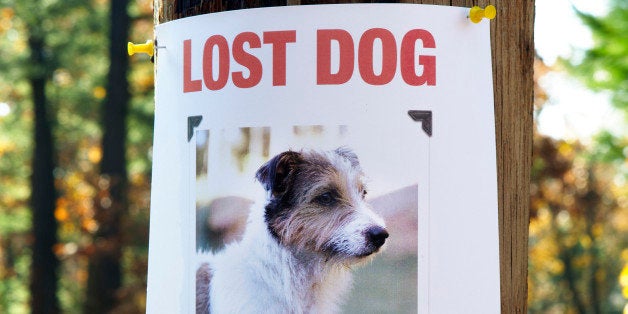
Some of the suggestions that follow are standard procedure, while others are a product of my years of working in shelters, rescue, and training. I sincerely hope they help you to find your dog.
Search your neighborhood:
Plan: On a map, draw a circle with your home at the center. Extend the radius a few miles so you can cover the area comprehensively and methodically. Begin with your normal dog-walking routes, and then move out to surrounding areas. Dogs are most active at dawn and dusk, so focus on those two time periods.
Walking search: Grab a leash and some super-stinky, yummy food your dog loves, such as sardines or hot dogs. If a favorite toy squeaks or jingles, bring it. If you have another dog, take that dog along; if not, but you have access to a dog yours is friendly with, ask the owner to accompany you.
As you walk, call your dog's name, jingle the toy, and keep the food exposed. Do visual sweeps, noticing areas such as bushes, undersides of cars, and other places a dog might take cover when sleeping, injured, or frightened. Brainstorm where your dog might venture: Dog parks? Woods? Fields? In a more urban environment, check the homes of neighboring canine friends. Arrange for someone to be at home in case your dog shows up while you're out.
Driving search: If possible, have someone else drive so you can focus on searching and calling out. For solo drives, go slowly, and keep your eyes on the road as you do peripheral sweeps of the area, calling your dog's name. If your dog knows, "Wanna go for a ride?" call his name followed by the phrase, uttered in the same happy tone you'd normally use. Whether searching by car or on foot, if your dog knows a verbal cue to come, use it with his name.
Photograph: Show recent photos -- preferably a headshot and a few full-body shots -- to everyone you encounter. If your dog is currently wearing a different collar, harness, or "clothing," say so. Give people a way to contact you.
Get the word out:
Inform your neighbors: As safety allows, knock on doors, and/or leave flyers. If your dog isn't people-friendly, don't expect anyone to attempt contact. Instead, give them animal control's number and yours, and ask them to call both if your dog is spotted. Even if your dog is friendly, ask that people not chase him, but instead turn their body to the side and clap gently, using a high-pitched, happy voice to lure him. If someone has a yard, ask them to coax your dog inside, close the gate, and call you. Let people know whether your dog is dog-friendly, in case they have dogs of their own.
Post "Lost" flyers around your neighborhood. Keep the text large and clean, and include a clear photo, preferably in color. "REWARD" should appear prominently. (Positive reinforcement works for people, too!) Create tear-off tags at the bottom with your phone number so only the tags get removed. Place flyers strategically, including poles at traffic signals and stop signs where motorists have time to read.
Post at veterinary offices, emergency clinics, shelters, groomers, kennels, pet supply stores, other dog-related businesses, and dog parks. Leave flyers at laundromats, supermarkets, community bulletin boards, and anywhere else that will allow it.
Distribute flyers to postal workers and delivery drivers, since they travel your neighborhood. Give them to kids (mention the reward)! Local dog walkers are not only out and about, but walk dogs who might attract yours. And don't forget bus drivers; taxi drivers; highway workers; utility workers; you get the idea.
Alert local trainers and groomers in case someone keeps your dog and engages their services. If your dog is purebred, alert the breed rescue even if it's not in your immediate area. If your dog is a mixed breed, alert the breed rescue for the predominant breed as well as mixed-breed rescues.
Spread the word online. Post information and photos on Facebook, Twitter, and other social media. Ask that it be shared.
Place "Lost dog" ads in your local and surrounding newspapers, and on Craigslist.
Search Shelters and Humane Societies:
Search locally and within roaming distance daily. Depending on where you live, strays may be euthanized after just a few days. Don't just call -- you must show up in person. The office staff might not know which dogs are there. And, your dog might have been designated as the wrong breed.
Search all pens, even those for the opposite sex, as mistakes get made. Don't skip the medical area! If your dog was hit by a car or otherwise injured, that's where he'll be. If you're not allowed inside, offer photos and ask staff to check. Check the Found postings in the lobby, too.
Miscellaneous:
Monitor rescue websites, both for your dog's breed and mixed breeds.
If you've got a GPS tracker on your dog, use it. Be aware of the range it covers.
There are companies that specialize in finding lost dogs. And, depending on where you live, there may even be services that use bloodhounds or other breeds to track them.
If you spot your dog:
Since the outside world is one big Doggie Disneyland, your dog might not run to you. If that happens, encourage him to chase you. If you're near home, run into your yard, then close the gate after him; away from home, try to maneuver to grab him gently. A trick you can try is to fall down and cry out in a high-pitched, distressed tone. Many concerned dogs will run to their "injured" owners.
Most importantly:
Think positive! Visualize your dog being home. Don't give up. I know of dogs who were taken in for a few months and then given up to a shelter. Keep looking, keep spreading the word, and stay strong.
Nicole Wilde is a canine behavior specialist and author. Visit her website www.nicolewilde.com.
Follow Nicole Wilde on Facebook: www.facebook.com/NicoleWildeAuthor
